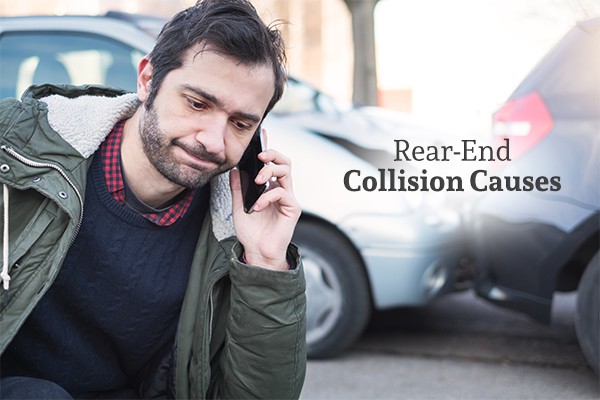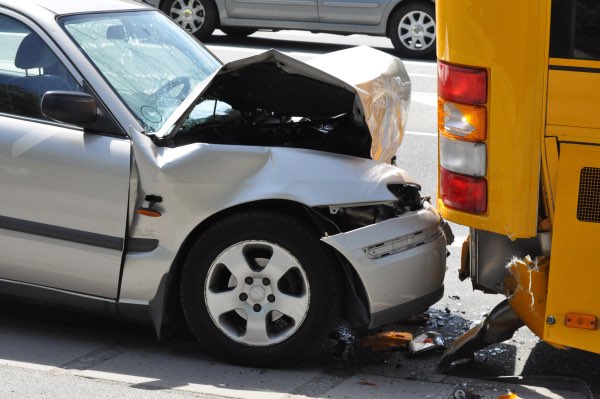
Rear-end collisions are the most common type of car accident, and they can occur at any time. According to the National Highway Transportation Safety Administration, rear-end collisions account for nearly 29% of all car accidents in the United States. Sometimes referred to colloquially as “bumpy crunchies” or other nicknames, these accidents can actually be quite serious. Although injuries may not be immediately prevalent, many drivers and passengers develop chronic conditions that leave them in pain for months or even years.
While some factors are out of the control of either driver, such as poor weather and road conditions, most rear-end collisions are caused by negligence. Here are the most common causes of rear-end accidents.
What Is a Rear-End Collision?
A rear-end accident occurs when a driver hits the vehicle directly in front of them from behind. They most often occur at stoplights, stop signs, and in congested traffic. A majority of rear-end collisions occur at lower speeds but when they do happen at high speeds they can result in major injury and damage.
What Are the Most Common Causes of Rear-End Collisions?

As mentioned earlier, many things can lead to a rear-end collision. Knowing what they are can help you make better decisions while on the road to lower the risk of an accident. Here are the most common causes:
1. Tailgating
Many people are guilty of tailgating at one point or another. After all, when someone is in a hurry, they want traffic to match their speed in order to reach their destination more quickly. But tailgating is both aggressive and dangerous. If the driver in front is forced to come to a quick stop, a tailgater may not be able to respond in time, resulting in a rear-end collision.
2. Speeding
Research from the National Highway Safety Administration (NHTSA) indicates that speeding accounted for 47% of roadway fatalities in 2019. While rear-end collisions are not usually fatal, they often involve cars traveling well above the posted speed limit.
Speeding doesn’t always relate to the posted limit; drivers also risk rear-end accidents when they fail to take dangerous road conditions into account. Drivers who easily avoid collisions while traveling on clear stretches of road may struggle when snow, ice, or rain are involved—especially if they don’t adjust their speed accordingly.
Hernandez Law Group Insight: Another common reason why drivers speed is because they are trying to get to their destination either on time while running late. However, statistically, drivers only save about six minutes from speeding. Always give yourself enough time to get to your destination safely—and even if you are running late, remember that those six minutes are not worth your life or someone else’s.
3. Distracted Driving
Everybody knows that texting or applying makeup behind the wheel is a bad idea. Yet, these and other sources of distraction remain alarmingly common on Texas roads. Every second a driver’s eyes leave the road, their car could travel hundreds of feet. This could prove perilous if another vehicle comes to a sudden stop or some other unexpected hazard arises. In these cases, a rear-end collision is unfortunately likely.
4. Drowsiness
Research suggests that sleep deprivation can be nearly as dangerous as intoxication behind the wheel since drowsy drivers are notoriously slow to respond to road hazards. This problem is more prevalent than most suspect; the AAA Foundation for Traffic Safety estimates that drowsy driving causes 328,000 crashes annually. Of these crashes, several are rear-end collisions.
5. Driving Under the Influence

A lot of drivers think they’re far more capable of safely navigating roads after drinking than they are. It doesn’t take a lot of alcohol to interfere with judgment or reaction time; just a drink or two can quickly compromise otherwise competent drivers. Drugs are just as dangerous—those under the influence of cannabis face similar issues with reaction time as those who drive drunk. Other drugs may prove even more dangerous, prompting aggressive driving behaviors, such as tailgating, or even hallucinations.
6. Traffic
While heavy traffic is rarely the direct cause of a rear-end collision, it makes such accidents far more likely. The unpredictable nature of stop-and-go road conditions leaves drivers more vulnerable to crashes, even at low speeds. Traffic has a way of exacerbating the risks associated with all of the behaviors outlined above. Drowsy or distracted drivers, for example, may be able to get by when few other vehicles are present but struggle to cope with traffic.
Every driver holds the responsibility and legal obligation to follow the rules of the road. Those who break these rules risk being involved in rear-end collisions, which can cause the driver ahead of them to experience years of suffering. A little more patience and attention to the road can make roads safer for all drivers.
Were You Injured In a Rear-End Collision?
If you were the victim of a rear-end collision, you deserve compensation for the damages. Look to the trusted team at the Hernandez Law Group, P.C. for assistance every step of the way. Unlike 98% of other Texas Lawyers, Juan Hernandez is board certified in personal injury law and has an impressive track record with car accident cases. Reach out today to learn more.
